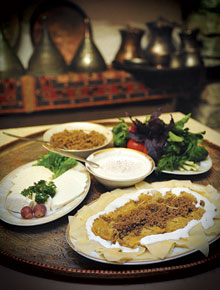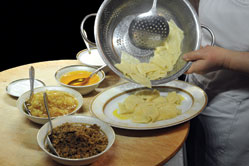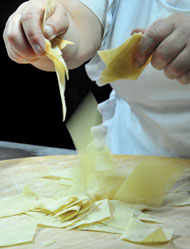As the mercury falls in the thermometer and nature retreats into quiet hibernation, the kitchen is a hive of activity. Azerbaijani cooks are preparing a traditional dish – khingal – that is usually eaten in winter or spring when a chill is in the air. Warming and filling, khingal is a favourite dish in most parts of Azerbaijan. Maybe there are as many regions of the country as there are different types of khingal – chicken khingal, khingal soup, pumpkin khingal, beshbarmaq and many more – but the most traditional variety is yarpag khingal. The name khingal means “made out of dough/pasta” and in yarpaq khingal the pasta is cut into ‘leaves’ (yarpaq) or sheets. Traditionally, an Azerbaijani housewife is judged by how well she rolls out dough for khingal. The sheets of dough should be very thin and neat.
This is how she does it. First, the skilful housewife makes a stiff dough from wheat flour, eggs, a pinch of salt and water. She kneads it well and then divides it into balls the size of a tennis ball. Then one ball at a time she rolls out the dough, using a thin rolling pin, similar to the tapered rolling pin favoured by Italian chefs, much thinner than the standard British or American equivalent. The dough should be as thin as possible (2-3 mm thick). Then she cuts the dough into diamond-shaped pieces, 5-6 cm long, the same shape used for traditional Baku baklava. She puts a large pan of water on the fire to boil. As the water comes to the boil, the housewife adds the sheets of pasta to the pan and leaves them to cook at a rolling boil for 5-10 minutes. When the pasta is cooked, she drains it through a colander and sets the pieces out on each plate. (She lays out any additional pasta sheets on a clean tea towel for 24 hours to dry, then stores them in a dry place for future use.)
Then she fries minced meat and onion (qiyma) in clarified butter. She melts some more butter and in a separate dish mixes qatiq (natural yoghurt) with minced garlic into a sauce. Now all that’s left is to assemble the dish. First she trickles melted butter over the khingal sheets, then adds the qatiq and garlic mixture and finally covers it with qiyma. The smell is something else! The khingal are ready! Nush olsun, we say. That means bon appétit! And may the khingal warm your body and soul!
Yarpaq khingal:
Ingredients
For the dough:
1 kg wheat flour
1 egg
pinch of salt
2 glasses of water
butter to serve
For the yogurt sauce:
100 g qatiq
1-2 cloves of garlic
For the qiyma (minced meat):
450 g minced lamb or mutton
2 onions
75 g clarified butter
salt & pepper
1. Sieve the flour and salt into a large bowl. Make a well in the centre and add the egg and 1 glass of water. Work into a light dough using your fingers (or if you find it easier you might want to start with a broad-bladed knife such as a palette knife and then use your hands). Add more water as necessary until all the flour is absorbed in the dough.
2. On a floured surface, knead the dough well for 10 minutes or so. Once it is elastic, divide the dough into tennis ball shapes. Place the balls on a tray, cover with an inverted bowl and leave to rest for 10 to 15 minutes.
3. Roll out the dough balls on a floured surface until the dough is 2-3 mm thick. Keep adding flour to stop the dough sticking to the surface or the rolling pin. Cut the rolled dough into broad strips and then into diamonds.
4. Put the dough shapes into a pan of boiling, salted water. Cook at a rolling boil until ready, approximately 10 minutes. Drain in a colander.
5. Chop the onions and fry in the clarified butter. Add the minced lamb and salt and pepper, and fry until cooked, usually around 20 minutes. Stir often to stop the mince burning.
6. Crush the garlic cloves and salt and add to the yogurt.
7. Melt the butter. Place the sheets of pasta on a large serving dish or individual plates and drizzle with the melted butter. Spread the garlicky yogurt over the pasta, then add the fried mince and onions – qiyma. Your yarpaq khingal are ready!





.jpg)